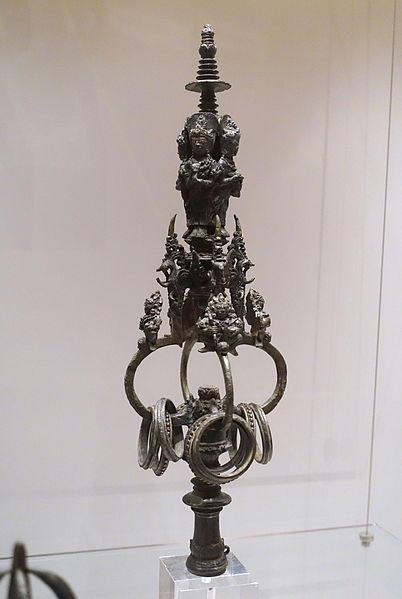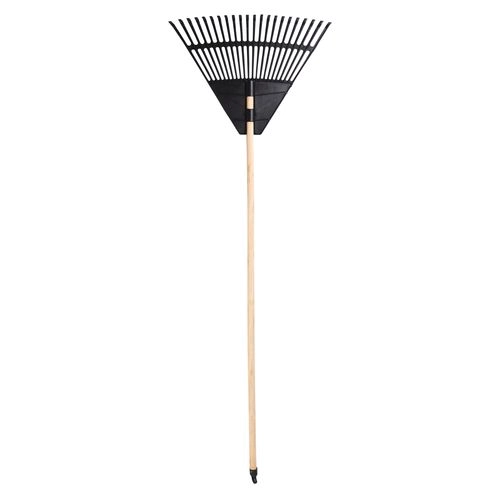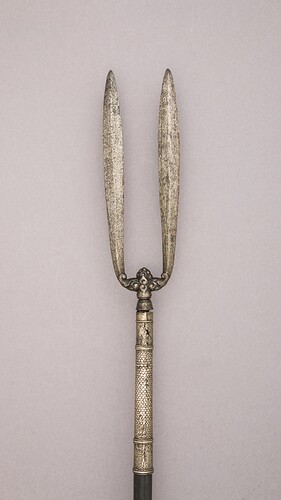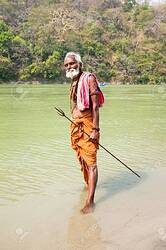I guess the stripes are functional: they are used to bind the metal prongs onto the wooden shaft.
It looks like a spear used in spear fishing. The monk carrying it looks purposeful. Yet it’s certainly not a fishing expedition.
From Khakkhara wiki:
Several versions of the staff’s origin are given in the Sarvastivada vinaya, but in all of them the staff is recommended to monks by the Buddha in order to ward off animals- either for protection from dangerous predatory animals like tigers and lions, or for scaring off small creatures like spiders and snakes that might be trod on by wandering monks.[3] The ringing of the staff can also alert donors within earshot of the monk’s presence, as monks traditionally remain silent while collecting alms.[3][7]
One of the younger monks I asked when pressed said it was used to assist walking, but that’s not practicable given the pointed head:
If it is a khakkhara, I wonder whether this is on a cultural continuum with Vietnamese Mahayana…or more part of some localised Theravada/Cambodian custom I don’t know about.
I vaguely recall seeing Cambodian monks with a bishop’s hat thing, too.
The photo is unclear tho, I’m not sure if the monk in question might just need a walking stick?
The Mahayana influence came from Indonesia:
"As a result, Jayavarman, as a young man, had lived in the court of Java and had visited Sumatra. When he returned to Cambodia, he proclaimed himself a god-king (deva-raja) according to Khmer traditions, identifying himself with Shiva. Nevertheless, he was increasingly friendly to and supportive of Mahayana Buddhist influence throughout his kingdom.[6]
"When King Jayavarman II (802-869) returned to Cambodia from Java, he built three capitals in succession: Hariharalaya, Amarendrapura, and Mahendraparvata. One of these, Amarendrapura, identified with Banteai Chmar, was a Mahayana Buddhist city presided over by Avalokitesvara, the Buddhist bodhisattva of compassion.
Mahayana Buddhism therefore became increasingly established in his empire."—Wikipedia
Bident from Java:
Mystery solved then, a khakkhara it is. 

I bet he was just being polite. Being pressed it would be embarrassing not to know. And why would you hold it that way to help with walking?
I think the only way to know for sure is to ask one of the monks holding it.
My cambodian friend implied that the staff might be a prop to enhance the spiritual credentials of the monk who carries it in the eyes of the lay community… A staff always add a bit of gravitas doesn’t it? A sense of authority! I know that in some monasteries monks are banned from using staffs because they are trading off the wise old ascetic image of great teachers like Ajahn Chah.
In one monastery I stayed at, there was a monk who had taken to walking staff in hand, appearing rather sage-like to the lay community but to us monks who knew him it seemed a tad affected and somewhat conceited! He was banned from doing it for the reason above.
But I’ve also heard of monks carrying staffs to ward off robbers and dogs in other countries.
Three spokes instead of two but
Maybe this is a practice stemming from “keeping up with the Joneses”?
I mean, if you are a forest monk, keeping snakes away might be a bit important, so this makes sense too.
I found this wikipedia article on Monk’s spade:
Khakkhara have large rings with smaller rings hanging off. Often with motifs like stupas. Thankfully some were preserved well. This one from Java seems like a great piece of art:

Along with the khakkhara and the crescent moon spade, some monks also had a walking stick with metal caps on the ends. The precedent for this last one was the Sarvastivada Vinaya.
I’m starting to wonder whether it is more of a Shiva bident.
Just from a practical point of view, this kind of tool would not be very good for deflecting snakes, so I doubt that is it’s primary purpose. The picture of the ‘Monks spade’ would be more useful in this regard, using the spade end.
When I walk in very ‘snakey’ areas I use a plastic garden rake as a walking stick  it is perfect for deflecting snakes without hurting them.
it is perfect for deflecting snakes without hurting them.

“Hades (/ˈheɪdiːz/; Greek: ᾍδης Hádēs; Ἅιδης Háidēs), in the ancient Greek religion and myth, is the god of the dead and the king of the underworld, with which his name became synonymous.[1] Hades was the eldest son of Cronus and Rhea, although the last son regurgitated by his father.[2] He and his brothers, Zeus and Poseidon, defeated their father’s generation of gods, the Titans, and claimed rulership over the cosmos. Hades received the underworld, Zeus the sky, and Poseidon the sea, with the solid earth, long the province of Gaia, available to all three concurrently.”—-Wikipedia
Hades carried the bident and is not synonymous with Mara. It seems the occasions on which the Cambodian monks carry the bident is key, and it may be when a death has occurred.
There is a correlation between the Greek myth and the suttas where the earth element differs from the three others in that it cannot in itself become provoked (ie is tranquil), but relies on the action of one of the other three:
"Now there comes a time, friends, when the external liquid property is provoked,[2] and at that time the external earth property vanishes.
[…]
"Now there comes a time, friends, when the external liquid property is provoked and washes away village, town, city, district, & country. “—-MN 28
I have a pet snake  and I learn to handle them, but the tool I used to move them when outside and too close to me is this
and I learn to handle them, but the tool I used to move them when outside and too close to me is this  very useful a d friendly to the snake.
very useful a d friendly to the snake.
I usually raise just a bit the back of the snake and move on to a more hidden secure place.  yet few may believe me, but the best protection is the Ahirājasutt. I have few personal anecdotes about that.
yet few may believe me, but the best protection is the Ahirājasutt. I have few personal anecdotes about that.
 I find mindfulness and ‘kindfulness’ to be the essential ingredients. I use a snake hook like yours when needing to move or ‘capture’ snakes in close quarters, but the rake is for out in the bush when 2 meters is a good length, and it doubles as a walking stick. Different tools for different purposes. If I had to design a tool it would look a bit different, but the good old plastic rake is good enough
I find mindfulness and ‘kindfulness’ to be the essential ingredients. I use a snake hook like yours when needing to move or ‘capture’ snakes in close quarters, but the rake is for out in the bush when 2 meters is a good length, and it doubles as a walking stick. Different tools for different purposes. If I had to design a tool it would look a bit different, but the good old plastic rake is good enough 
Overall, learning to live with snakes provides heaps of opportunities to practice Dhamma 


I questioned a householder living along the alms route, and their information was the monks carry the bident when “the farmer receives the rice” of a harvest. Further work needs to be done to establish the role of the bident in this ritual.
If you would like to publish as much as you can about Cambodian Buddhist customs, I would be interested. 
I don’t get full satisfaction out of publishing things without being able to trace the answer, however have gathered more information from this discussion. What needs to be done is university level research.
You may get some constructive information on the transmission of Theravada into Cambodia from this thesis on the Earth Goddess :


